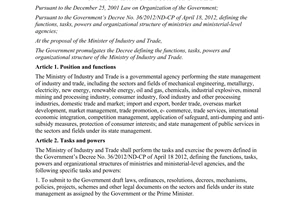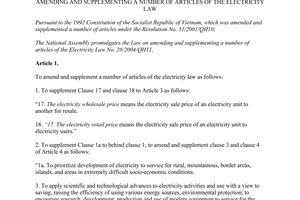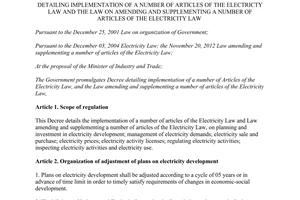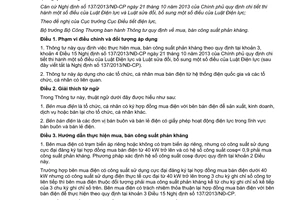Nội dung toàn văn Circular No. 15/2014/TT-BCT on reactive power trading
|
MINISTRY OF
INDUSTRY AND TRADE |
SOCIALIST REPUBLIC OF VIETNAM |
|
No: 15/2014/TT-BCT |
Ha Noi, May 28, 2014 |
CIRCULAR
ON REACTIVE POWER TRADING
Pursuant to Decree No. 95/2012/ND-CP dated November 12, 2012 of the Government defining the functions, tasks, powers and organizational structure of the Ministry of Industry and Trade;
Pursuant to Law on Electricity dated December 3, 2004 and Law on amendments to Law on Electricity dated November 11, 2012;
Pursuant to Decree No. 137/2013/ND-CP dated October 21, 2013 of the Government on guidelines for the Law on Electricity and Law on amendments to Law on Electricity;
At the request of Director of Electricity Regulatory Authority,
The Minister of Industry and Trade issued Circular regulating on reactive power trading
Article 1. Scope and regulated entities
1. This Circular deals with reactive power trading as prescribed in Clause 3 and Clause 4 Article 15 of Decree No. 137/2013/ND-CP dated October 21, 2013 of the Government on guidelines for the Law on Electricity and Law on amendments to the Law on Electricity (hereinafter referred to as Decree No. 137/2013/ND-CP).
2. This Circular applies to entities who purchase and sell electricity from the national grid and relevant entities.
Article 2. Interpretation of terms
For the purposes of this Circular, these terms below shall be construed as follows:
1. Electricity purchaser means any entity who signs a Power purchase agreement with an Electricity seller to serve the purchaser’s business operation or to resell electricity to other entities.
2. Electricity seller means any electricity wholesaler or retailer having licenses for electricity wholesaling or retailing.
Article 3. Guidance on reactive power trading
1. Any electricity purchaser that uses a maximum power of 40 kW or over under the power purchase agreement and power factor cosφ is smaller than 0.9 must purchase reactive power, whether the purchaser has their own substation or not. The method to determine power factor cosφ is prescribed in Clause 2 of this Article.
In case the electricity purchaser registers maximum power of lower than 40 kW in the Power purchase agreement but the actual maximum power is over 40 kW after three consecutive billing periods, the electricity purchaser must purchase the reactive power from next billing period. The electricity purchaser must negotiate a new Power purchase agreement with the electricity seller in accordance with Clause 3 Article 15 of Decree No. 137/2013/ND-CP
2. Power factor cosφ , which is used for determination of reactive power purchase, is determined according to the data of electricity meters in a billing period as follows:
Where:
Cosφ = 
Ap: Active energy in the billing period (kWh);
Aq: Reactive energy returned in the billing period is the consumption of reactive power of electrical equipments over a billing period (kVArh).
3. In case the electricity purchaser signs a contract that covers multiple electricity meters at a location powered by the same medium-voltage or high-voltage line, the active energy shall be total active energy recorded by the electricity meters and the reactive energy shall be total reactive energy recorded by the electricity meters.
4. In case the electricity purchaser uses electricity for other purposes besides their business operation, the power factor cosφ is determined as follows:
Where electricity serving business operation is measured by a separate electricity meter, only reactive power for such purpose shall be purchased.
b) Where electricity serving business operation is not measured separately and total electricity consumption is measured by only one electricity meter, the electricity purchaser must purchase reactive power for the total electricity consumption if power factor cosφ is <>
5. The payment for reactive power, which is the amount that the electricity purchaser must pay the electricity seller in order to compensate for additional expenses that are incurred due to the overuse of reactive power of electricity purchaser, shall be calculated as follows:
Where:
Tq = Tp x k %
Tq: Payment for reactive power (exclusive of VAT tax);
Tp: Payment for active energy (exclusive of VAT tax);
k: Compensation coefficient for overuse of reactive power of electricity purchaser as prescribed (%)
Coefficient k as defined in below table:
|
Power factor Cosφ |
k (%)
|
Power factor Cosφ |
k (%) |
|
≥ 0.9 |
0 |
0.74 |
21.62 |
|
0.89 |
1.12 |
0.73 |
23.29 |
|
0.88 |
2.27 |
0.72 |
25 |
|
0.87 |
3.45 |
0.71 |
26.76 |
|
0.86 |
4.65 |
0.7 |
28.57 |
|
0.85 |
5.88 |
0.69 |
30.43 |
|
0.84 |
7.14 |
0.68 |
32.35 |
|
0.83 |
8.43 |
0.67 |
34.33 |
|
0.82 |
9.76 |
0.66 |
36.36 |
|
0.81 |
11.11 |
0.65 |
38.46 |
|
0.8 |
12.5 |
0.64 |
40.63 |
|
0.79 |
13.92 |
0.63 |
42.86 |
|
0.78 |
15.38 |
0.62 |
45.16 |
|
0.77 |
16.88 |
0.61 |
47.54 |
|
0.76 |
18.42 |
0.6 |
50 |
|
0.75 |
20 |
<> |
52.54 |
6. Electricity purchaser must pay for purchased reactive power when paying for purchased active power the invoices for purchased reactive power shall be issued in accordance with regulations of the Ministry of Finance Outstanding payments for purchased reactive power shall be handled similarly to outstanding payments for purchased active energy.
7. In case the electricity seller fails to ensure electricity quality as prescribed in Decree No. 137/2013/ND-CP dated October 21, 2013 of the Government on guidelines for the Law on Electricity and Law on amendments to the Law on Electricity, the electricity purchaser shall not be required to purchase reactive power though power factor cosφ is below 0.9.
8. In case electricity purchaser is capable of generating reactive power on the grid and electricity seller wishes to purchase reactive power, both parties shall enter into a contract to purchase reactive power. In case two parties fail to reach an agreement, they may request the Ministry of Industry and Trade to consider and make a decision.
Article 4. Effect
1. This Circular takes effect from December 10, 2014; Circular No. 07/2006/TT-BCN dated November 27, 2006 of the Ministry of Agriculture and Rural Development providing guidance on reactive power trading is annulled since this Circular takes effect.
2. Difficulties that arise during the implementation of this Circular should be directly reported to the Electricity Regulatory Authority for consideration or reported to the Ministry of Industry and Trade for settle./.
|
|
PP THE
MINISTER |




